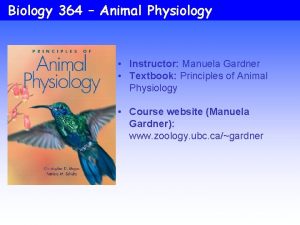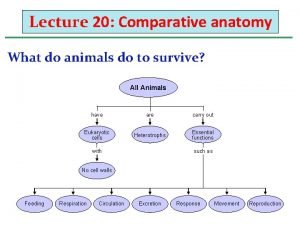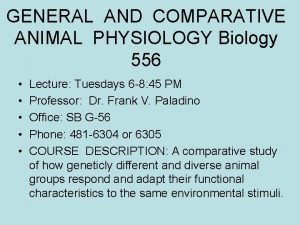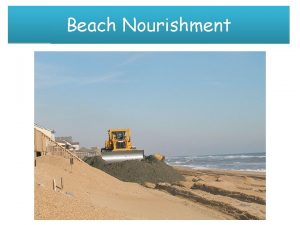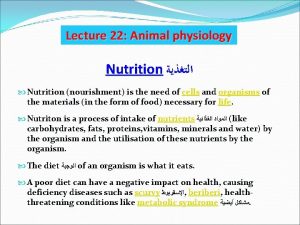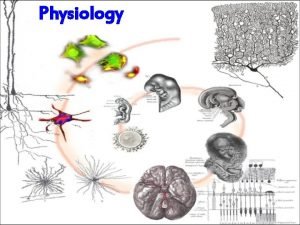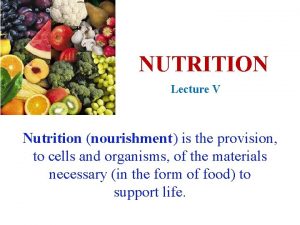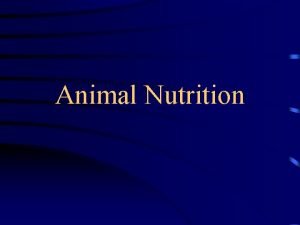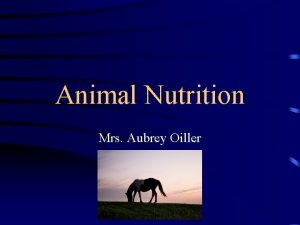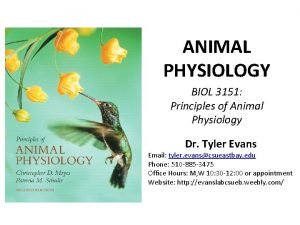Lecture 22 Animal physiology Nutrition Nutrition nourishment is









- Slides: 9

Lecture 22: Animal physiology Nutrition ﺍﻟﺘﻐﺬﻳﺔ Nutrition (nourishment) is the need of cells and organisms of the materials (in the form of food) necessary for life. Nutriton is a process of intake of nutrients ( ﺍﻟﻤﻮﺍﺩ ﺍﻟﻐﺬﺍﺋﻴﺔ like carbohydrates, fats, proteins, vitamins, minerals and water) by the organism and the utilisation of these nutrients by the organism. The diet ﺍﻟﻮﺟﺒﺔ of an organism is what it eats. A poor diet can have a negative impact on health, causing deficiency diseases such as scurvy ﺍﻹﺳﻘﺮﺑﻮﻁ , beri, healththreatening conditions like metabolic syndrome ﻣﺸﺎﻛﻞ ﺃﻴﻀﻴﺔ.

Nutrients ﺍﻟﻤﻮﺍﺩ ﺍﻟﻐﺬﺍﺋﻴﺔ There are seven major classes of nutrients: carbohydrates, fats, fiber, minerals, protein, vitamin, and water. They are classified into two kategories: I)- Macronutrients ﻣﻐﺬﻳﺎﺕ ﻛﺒﻴﺮﺓ : needed in relatively large amounts. They are carbohydrates, fats, fibers ﺃﻠﻴﺎﻑ , proteins, and water. II)- Micronutrients ﻣﻐﺬﻳﺎﺕ ﺻﻐﻴﺮﺓ : needed in smaller quantities. They are minerals ﺍﻷﻤﻼﺡ ﺍﻟﻤﻌﺪﻧﻴﺔ and vitamins.

The macronutrients (but not fibers and water) provide structural material ﻣﻮﺍﺩ ﺑﻨﺎﺋﻴﺔ for example (amino acids from which proteins are built) and (lipids from which cell membrane is built). Some of the structural materials can be used to generate energy internally ﻟﺘﻮﻟﻴﺪ ﺍﻟﻄﺎﻗﺔ ﺩﺍﺧﻠﻴﺎ , and measured in kilocalories ( ﻛﻴﻠﻮ ﻛﺎﻟﻮﺭﻱ often called "Calories"). I- Carbohydrates and proteins provide 4 kcal of energy per gram. II- while fats provide 9 kcal per gram. Vitamins, minerals, and water do not provide energy, but are required for other reasons. Fibers (i. e. , non-digestible materials such as cellulose), seems to be required, for both mechanical and biochemical reasons.

Fats are triglycerides, made of fatty acid monomers bound to glycerol backbone. Some fatty acids, but not all, are essential in the diet: they cannot be synthesized in the body. Protein molecules contain amino acids, some of which are essential (the body can not make them internally). Some of the amino acids are convertible to glucose and can be used for energy production just as ordinary glucose during prolonged starvation. Most foods contain a mix of some or all of the nutrient classes, together with other substances such as toxins or various sorts. Some nutrients can be stored internally (eg, some vitamins), while others are required more or less continuously. Poor health results from a lack of required nutrients or, too much of a required nutrient. For example, both salt and water (both are required) but cause illness (or even death) in too large amounts.

Digestion ﺍﻟﻬﻀﻢ Digestion: is the mechanical and chemical breaking down ﺗﻜﺴﻴﺮ of food into smaller components, to a form that can be absorbed ﻣﺘﺺ. Digestion is a form of catabolism that means break down of macro-food molecules ﺃﺠﺰﺍﺀ ﺍﻟﻄﻌﺎﻡ ﺍﻟﻜﺒﻴﺮﺓ to smaller one. a)- Extracellular digestion ﺍﻟﻬﻀﻢ ﺧﺎﺭﺝ ﺍﻟﺨﻠﻴﺔ : In mammals, food enters the mouth, being chewed by teeth, and broken down by the saliva ﺍﻟﻠﻌﺎﺏ from the salivary glands. Then it travels down the esophagus ﺍﻟﺒﻠﻌﻮﻡ into the stomach ﺍﻟﻤﻌﺪﺓ , where acid begins physical break down of some food. The food go through the small intestine ﺍﻷﻤﻌﺎﺀ ﺍﻟﺪﻗﻴﻘﺔ , through the large intestine ﺍﻷﻤﻌﺎﺀ ﺍﻟﻐﻠﻴﻈﺔ , and are excreted outside. b)- Intracellular digestion ﺍﻟﻬﻀﻢ ﺩﺍﺧﻞ ﺍﻟﺨﻠﻴﺔ : Some other unicellular organisms ﺍﻟﻜﺎﺋﻨﺎﺕ ﻭﺣﻴﺪﺓ ﺍﻟﺨﻠﻴﺔ use different mechanisms to digest food inside the cell.

Digestive systems ﺍﻟﺠﻬﺎﺯ ﺍﻟﻬﻀﻤﻲ Once food is inside the organism, digestion can be conducted in the cytoplasm, in a vesicle , through a tube, or through specialized organs aimed at making the absorption of nutrients more efficient. Diggestive systems are classified into two kategories: a -(Gastrovascular cavity : ﺍﻟﺘﺠﻮﻳﻒ ﺍﻟﻮﻋﺎﺋﻲ ﺍﻟﻤﻌﻮﻱ functions as a stomach in both digestion and the distribution of nutrients to all parts of the body. Digestion takes place within this central cavity ﺍﻟﺘﺠﻮﻳﻒ ﺍﻟﻤﺮﻛﺰﻱ which has only one opening to the outside that functions as both a mouth ﻓﻢ and an anus ﺷﺮﺝ. So, it is described as an incomplete gut ﻣﻌﻲ ﻏﻴﺮ ﻛﺎﻣﻞ. b)- Complete gut : ﺍﻟﻤﻌﻲ ﺍﻟﻜﺎﻣﻞ has specialized organs ﺃﻌﻀﺎﺀ ﻣﺘﺨﺼﺼﺔ that aid in the digestion of their food. Here, animals were created with organs such as beaks ﻣﻨﺎﻗﻴﺮ , tongues ﺃﻠﺴﻨﺔ , teeth ﺃﺴﻨﺎﻥ , a crop ﺣﻮﺻﻠﺔ , gizzard ﺍﻟﻘﺎﻧﺼﺔ , and others.

1. Beaks: birds eat primarily seeds, nuts, and fruit, using their beaks to open even the toughest seed ﺍﻟﺒﺬﻭﺭ ﺍﻟﺠﺎﻓﺔ. 2. Tongue: is skeletal muscle on the floor of the mouth that manipulates food for chewing ( )ﺍﻟﻤﻀﻎ and swallowing ( )ﺍﻟﺒﻠﻊ. The underside of the tongue is covered with a smooth mucous membrane ﻏﺸﺎﺀ ﻣﺨﺎﻃﻲ. The tongue is utilized ﻳﻮﻇﻒ to transport food down to the esophagus. 3. Teeth: (singular, tooth) are small whitish structures found in the jaws ( )ﺍﻟﻔﻜﻮﻙ of many vertebrates that are used to chew food ﻣﻀﻎ ﺍﻟﻄﻌﺎﻡ. They are not made of bone, but rather of tissues of varying density and hardness. - Teeth of carnivores آﻜﻼﺕ ﺍﻟﻠﺤﻮﻡ are shaped to kill and tear meat ﻭﺗﻤﺰﻕ ﺍﻟﻠﺤﻢ. - Teeth of herbivores آﻜﻼﺕ ﺍﻟﻌﺸﺐ are made for grinding ﻃﺤﻦ plant parts.

4. Crop: is a thin-walled expanded portion ﺟﺰﺀ ﻭﺍﺳﻊ ﺭﻓﻴﻊ ﺍﻟﺠﺪﺍﺭ of the alimentary canal used for the storage of food prior to digestion ﺗﺨﺰﻳﻦ ﺍﻟﻄﻌﺎﻡ ﻗﺒﻞ ﺍﻟﻬﻀﻢ. In some birds it is an expanded, muscular pouch ﻛﻴﺲ near throat ﻗﺮﺏ ﺍﻟﺰﻭﺭ. In adult pigeons, the crop can produce crop milk ﻟﺒﻦ ﺍﻟﺤﻮﺻﻠﺔ to feed newly hatched birds. Certain insects may have a crop or enlarged oesophagus. 5. Gizzard: is a specialized stomach with thick ﺳﻤﻴﻚ , muscular walls used for grinding up food ﻃﺤﻦ ﺍﻟﻄﻌﺎﻡ. Birds and cockroaches have developed gizzards to assist in the digestion of tough materials. The gizzard can grind food with stones that have been swallowed and pass it back to the true stomach and vice versa.

6. Abomasum ﺍﻟﻤﻌﺪﺓ ﺍﻟﺤﻘﻴﻘﻴﺔ Herbivores have evolved cecums (or an abomasum in the case of ruminants )ﺍﻟﺤﻴﻮﺍﻧﺎﺕ ﺍﻟﻤﺠﺘﺮﺓ. Ruminants have a fore-stomach ﻣﻌﺪﺓ ﺃﻤﺎﻣﻴﺔ with four chambers. These are the rumen ﺍﻟﻜﺮﺵ , reticulum ﺍﻟﺸﺒﻜﻴﺔ , omasum ﺍﻟﻮﺭﻗﻴﺔ , and abomasum( ﺍﻷﻨﻔﺤﺔ )ﺍﻟﻤﻌﺪﺓ ﺍﻟﺤﻘﻴﻘﻴﺔ : ü In the first two chambers (the rumen & the reticulum) the food is mixed with saliva and separates into solid and liquid materials. The solid is then regurgitated ﺳﺘﺮﺟﻊ , chewed slowly ﻳﻤﻀﻎ ﺑﺒﻄﺀ to completely mix it with saliva and to break down the particle size. ü In the 3 rd chamber (omasum) water and many of the inorganic mineral elements are absorbed into the blood stream. ü The 4 th chamber (abomasum) which is equivalent of the human stomach. It serves primarily as a site for digestion of microbial and dietary protein. Digesta is finally moved into the small intestine for absorption of nutrients.
 Unit 26 agriscience
Unit 26 agriscience Unit 26 animal anatomy physiology and nutrition
Unit 26 animal anatomy physiology and nutrition Food webs in the desert
Food webs in the desert Food chain consumer levels
Food chain consumer levels Microbial physiology and metabolism lecture notes
Microbial physiology and metabolism lecture notes 01:640:244 lecture notes - lecture 15: plat, idah, farad
01:640:244 lecture notes - lecture 15: plat, idah, farad Animal physiology definition
Animal physiology definition Human physiology exam 1
Human physiology exam 1 Animal physiology
Animal physiology Comparative animal physiology notes
Comparative animal physiology notes






